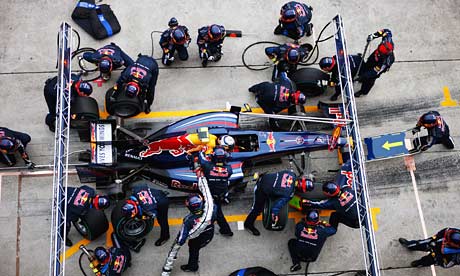

Sebastian Vettel of Red Bull in the pits during the Malaysian Grand Prix, 5 April 2009. Photograph: Mark Thompson/Getty Images
On the 13th lap of the Malaysian Grand Prix, Sebastian Vettel speeds into the pits at 100kph before halting precisely for new tyres and fuel. Red Bull's crew drill for months to perfect this eight-second exchange - the slightest error can make the difference between a podium place and a pointless finish.
1. Lollipop man
"There's no such thing as an easy job in the pits," says Red Bull team manager Jonathan Wheatley, "but being lollipop man is hard." Benefiting from eyes like a velociraptor's, the 'pop man must simultaneously watch the activity on all four wheels as well as the fuel rig, and keep tabs on traffic in the pit lane before sending the car off with a twist of his pole. A crucial moment comes about halfway through, when he swivels his sign to tell the driver to start revving his engine. "Get those revs going too early and the exhaust will heat up and set the bodywork on fire," says Wheatley.
2. Fuel rigger
Filled with fuel, the rig is so heavy it requires two men to manoeuvre it; a third kneels behind, poised to flip the terrifying-sounding "dead man's handle", shutting off the flow should anything go wrong. Wheatley knows the dangers of refuelling: he was on the Benetton crew when a petrol leak turned Jos Verstappen's car into a fireball in the pits at the 1994 German GP. "It doesn't matter about training in those situations," he recalls, "the heat is indescribable, and everyone runs in every direction of the compass. Fortunately there hasn't been a repeat." And there is unlikely to be, if a plan to scrap refuelling in Formula One is implemented next season. That would reduce the crew's job to wheel changes; pit stops could last as little as three seconds and would need five fewer personnel.
3. Cornermen
Each corner of the car is serviced by three men: one to take a wheel off, one to put a new wheel on, and one to remove and replace the fist-sized wheel nut with a gun-like drill. Most people want to hold the gun, and the Red Bull team decide who will fill this position after a Wild West-like "gun contest" at their Milton Keynes factory during the winter. The little blue scarves on their necks are cold towels, it being rather toasty in Malaysia, particularly when you are wearing fireproof gear.
4. Engine air filler
With his Boba Fett-style backpack (actually a cylinder of compressed air) he is responsible for servicing the engine's pneumatic valve system. Except that, like the chap to the right poised with a spare steering wheel, he isn't often called into action. "We don't fly anyone in just to do pit stops," says Wheeler. "They all have other roles, as mechanics, truck drivers, gearbox specialists, IT personnel - we even used the team physiotherapist on the crew a few seasons ago."
5. Jack men
The jack men at the front and the back of the car - who lever it from the ground so that the wheels can be removed - have to slot their jacks into a specific area under the car with around 10mm room for error. To get precision details like this correct, the Red Bull team practise their stops thousands of times a year, using old cars at their UK factory in the winter and then with live cars at races once the season starts. Sadly, the hours of graft were of little use in Malaysia: five laps after the flawless completion of the stop, the Sepang track was drenched by a tropical storm, causing Vettel to skid out of contention on lap 31, and the entire race to be abandoned soon after.
No comments:
Post a Comment